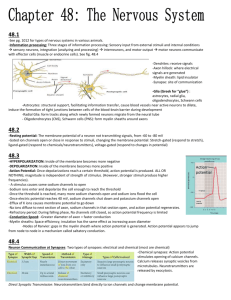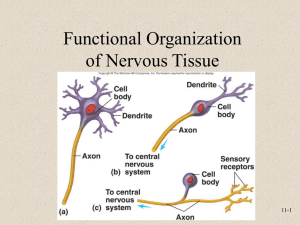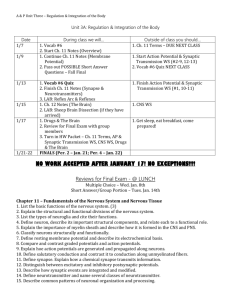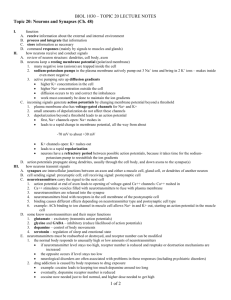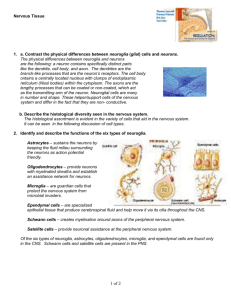Nervous system lecture 1
advertisement
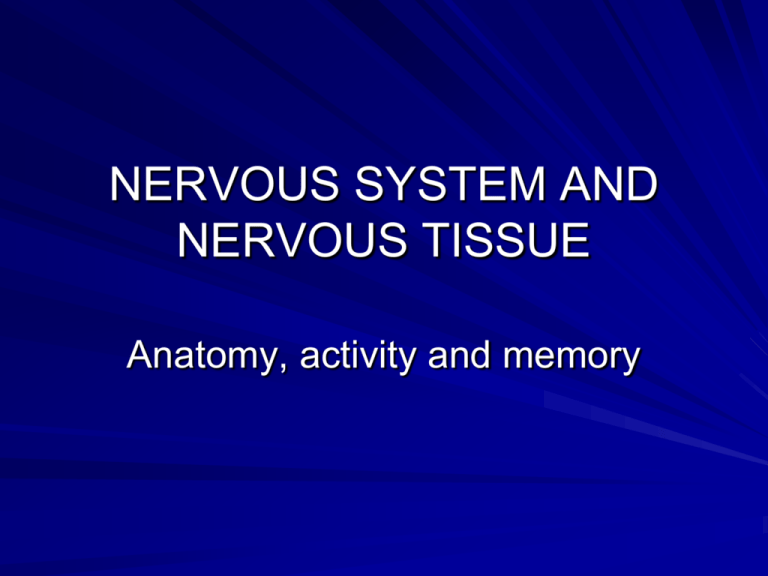
NERVOUS SYSTEM AND NERVOUS TISSUE Anatomy, activity and memory Nervous System – Ch 11 General scheme, fig 11.1 – Receives information from receptors– sensory input. – Interprets and develops a plan of action – integration. – Sends plan of action to effector(s) – motor output. Organization of the Nervous System Central Nervous System (CNS) – spinal cord and brain; interpretation & integration, fig 11.2. Peripheral Nervous System (PNS) – links the rest of the body to the CNS. – 12 pair of cranial nerves and 31 pairs of spinal nerves. Organization of the Nervous System PNS divisions – Sensory division (afferent) – relays information from receptors to CNS – Motor division (efferent) - relays information from CNS to effectors. Organization of the Nervous System Histology 80% cells; neurons and neuroglia (supporting cells). 10X as many neuroglia as neurons. Neuroglia of the CNS, 4 types (fig 11.3) – Astrocytes – – Microglia – Histology Neuroglia of the CNS cont’d – Ependymal – – Oligodendrocytes – – **Brain tumors Neuroglia of the PNS, 2 types – Satellite cells - ?function – Schwann cells – form myelin sheaths Histology Neurons (fig 11.4) – Features: very irritable, long lived, amitotic (except in the hippocampus?), high metabolic rate. – Cell body (soma): large single nucleus with a prominent nucleolus, Nissl bodies (rough ER) and Golgi apparatus, + other organelles. Biosynthetic center. Primarily located in CNS Histology Neurons cont’d – Processes Dendrites – usually branched, input or receptive regions; carry impulses TOWARD the cell body. Axons – usually one per cell, arise from axon hillock, short to very long, terminal branches. Output regions, carry impulses AWAY from the cell body. Nutrients and repair parts (proteins, etc) travel from cell body to axon and back again. **Viruses and bacteria. Histology Neuron (fig 11.5) – Myelin sheaths: protein/lipid sheet wrapped around axons only, outer layer is neurilemma. Discontinuous - spaces are Nodes of Ranvier. Functions: electrically insulate axon and speed up transmission of electrical impulses. – Gray matter – unmyelinated axons and cell bodies – White matter – myelinated axons Neurophysiology - Review Membrane Ion Channels (fig 11.6) Neurophysiology - Review RMP (fig 11.7 & 11.8) – Cell membrane at rest is polarized, negative inside vs. outside (-40 to -90 mV). – Generated by different concentrations of Na and K inside the cell and out. – Resting membrane maintained by Na+ K+ ATPase. Synapses The nervous system is like telegraph or “old” telephone lines. Synapse = connection points among the lines (neurons). – Electrical – Chemical There may be 100’s or 1000’s of synapses on a single neuron. Chemical Synapse Model Chemical Synapses in Nervous System Types of chemical synapses based on position: – Axodendritic – Axosomatic – Axoaxonic, etc **Presynaptic neuron vs Postsynaptic neuron Neurophysiology Membrane potentials that act as signals, fig 11.9 – Depolarization: decreases membrane potential (less negative). – Hyperpolarization: increases membrane potential (more negative). – Graded potentials – local changes in membrane potential. Short lived, magnitude varies with stimulus strength. Neurophysiology Membrane potentials that act as signals – Graded potentials cont’d EPSP – IPSP – Function: control of unintentional or unnecessary impulses to and from your brain. Neurophysiology Membrane potentials that act as signals – Graded potentials Summation – combination of these graded, local potentials at the axon hillock can bring about an action potential or inhibit the generation of the action potential. – Spatial: stimulation by many neurons at one time. – Temporal: increased numbers of impulses per minute. Summation of Graded Potentials Neurophysiology Membrane potentials that act as signals – Action Potential – rapid and large change in membrane potential, i.e. from -50 to +30 mV. Occurs only in axons = nerve impulse. – Action Potential and ion channels – review??? Memory – Ch 12 Basis: Most neurons are amitotic but new synapses form continually and existing synapses can be “trained” to work more efficiently. – Repeated EPSPs at the synapses of the same neuronal pathway causes physical changes called LONG TERM POTENTIATION. – Receptor proteins are altered to respond more quickly or more dramatically and generate an AP. – Studying – reading is input; recall or output = write it, say it, explain it, draw it, act it out, etc. Memory - Stages Short-term (STM) – working memory (RAM on the computer). – Limited to 7-8 “chunks” of information. – May be forgotten immediately. Long term (LTM) is like information on the hard disk on the computer). – Limitless – Conversion of STM to LTM is affected by emotional state, rehearsal and association but can be automatic. Memory Categories: – Declarative (facts) – Non-declarative: procedural (skills), motor, emotional memories. Come from practice and experience. – Involve different pathways in brain??? Storage in different areas of the brain – association areas near sensory/motor areas concerned with that particular cue. Proposed Memory Circuits Declarative Procedural Figure 12.23 Memory Mechanisms - what has been observed: – Increased mRNA synthesis – Changes in dendrites – “New” protein at synapses involved in LTM – Increased number and size of presynaptic terminals and neurotransmitter released – “New” neurons in the hippocampus.
